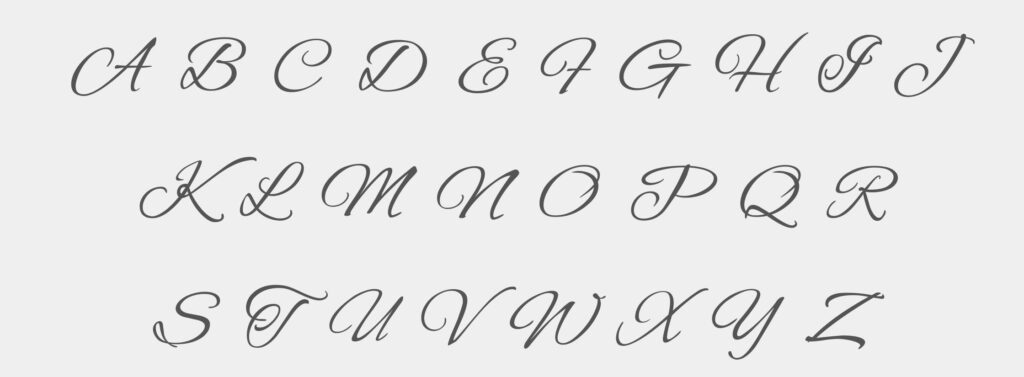If you’re interested in learning how to write in cursive, chances are you already know about cursive lettering. Well, in schools, students are taught writing in cursive style. However, if you like script writing and want to learn this style, you should definitely practice cursive calligraphy.
In this blog, we will take you through some crucial steps towards cursive lettering a to z. But first, you should know what cursive font is.
What is Cursive Writing?
Cursive is a style of handwriting, in which the letters and alphabets are joined with each other in a particular manner to form a word. This writing is generally faster as compared to block writing.
How to Write Cursive Letters?
Let’s dive into the steps mentioned below to practice cursive lettering.
Step I
Get a few blank sheets to practice cursive calligraphy on them.
Step II
Now, start practicing with the basic strokes and utilize two to three lines for a warm-up. Remember, cursive lettering is written by joining letters to each other. Make sure to connect these letters hassle-freely to make them readable.
Step III
First, practice with the upward stroke from the bottom of the line and then rise to the top line.
Step IV
Begin your practice with the basic curve stroke for one or two lines to get prepared. But this time, you need to bend the letters more than before. You should start with a little under the dashed lines and go up in a clockwise direction towards the bottom line and curve it up with a little gap.
Now that you’ve learned basic cursive lettering, there are different ways to write in cursive style in upper and lower cases.
4 Steps to Write Upward Stroke in Lowercase Letters

The upward stroke is used to start the letters including b, f, h, i, j, k, l, m, n, p, r, s, t, u, v, w, x, y, and z. Some merely extend to the dashed line, while others have strokes that cover the entire height of the line. A few also extend underneath the bottom line, like the “f.”
Let’s demonstrate the direction of each stroke. When writing the letters by hand, you can first make a pencil sketch of them. Then all you have to do is use your pen to trace the pencil lines. This is also useful for mastering the cursive “k” letter.
Step I
Let’s begin with the “u,” since it’s the simplest letter. Put the tip of your pencil on the bottom line. The dotted line should be raised. Then, use a descending stroke that turns back upward after dipping to the bottom line. Continue drawing downward until you reach the area right below the dashed line. There you go! You have a “u” in the twisted script. Right, it was somewhat reminiscent of tracing waves on the ocean.
Step II
To obtain a sense of how to make the letter “u,” repeat the technique three times. The letters i, j, m, n, r, v, w, and y, among others, are nearly identical to the letter “u.” Once you understand how to make a “u,” additional characters become clear.
Step III
Now let’s move toward the letter “h.” While the “h” begins similarly to the “u,” its stroke extends all the way to the top line. After that, you form a leftward curve and a descending stroke toward the baseline. Near that line, you’ll pass over your previous line. Curve up to the dotted lines then, and return to the baseline with a lower stroke, curling up, and finish right underneath the dotted lines.
Step IV
To obtain a sense of how to make the letter “h,” practice the technique for a few times. A lot of characters, including the b, f, k, and l, resemble the “h.” Use the strokes as a reference, and slowly complete the remaining lowercase letters with curved strokes.
Write Curved Stroke in Lowercase Letters in a Couple of Steps
Now, let’s do cursive exercises with some more lowercase letters in curved style. The entrance stroke for the letters a, c, d, e, g, o, and q extends from the baseline to just beneath the dotted lines. After finishing our entrance stroke, we turn and bend counterclockwise.
However, you can always draw the letters with a pencil first to write hassle-freely. Then all you have to do is use your pen to trace the pencil lines.
Step I
Let’s begin with the letter “o”, since it’s the simplest. Just over the baseline, put the tip of your pencil. Close the space just under the dotted lines by arcing up just beneath it and stroking counterclockwise. Following a short descent, pull out until it reaches the dotted line. You have an “o” in lettering. It’s not that hard! Right?
Step II
Try out a tougher letter like “g.” The “g” must begin in a similar way as the “o,” but rather than looping around in a circle, it should rise upward and close the space. Then go through the baseline with a down stroke. Curve to the left and draw a diagonal upstroke that rises toward and terminates just beneath the dashed line. Right at the bottom line, it should cross your “g’s” downward stroke. Utilize these strokes as a direction and gradually complete the remaining lowercase letters with curved strokes.
How to Write Cursive Letters in Uppercase?

The cursive lettering in uppercase alphabets is always more complex and functions under various rules. The upward strokes have many twists and bends, and a tilt to them, while the curving strokes are much larger. In addition, writing uppercase and lowercase letters is equally straightforward.
To feel at ease, you can also draw the letters with a pencil initially. Then all you have to do is use your pen to trace the pencil lines. It is preferable to draw out the uppercase letters before writing them.
Step I
First of all, we didn’t separate the alphabet into groups because the majority of the cursive script letters start with a curved stroke. Instead, we’ll just proceed, checking the direction of the strokes as we go using the above reference.
So let’s begin with the simplest letter, “L.” Put the tip of your pen just below the top line. Curve down just over the dotted lines and around counterclockwise, starting to come to the highest line. Then bend over to the left and make a descending stroke to the baseline. Your line will be tilting to the right side. Curl up and around when you get to the bottom. Lastly, stroke your line out to the right, forming a nice, smooth curve. Once you understand how to make the letter “L,” in a cursive style, it is simple to understand how to create the capital letters C, E, G, O, and Q.
Step II
Now, let’s try the more difficult letter like “R.” Put the tip of your pencil on the top line first. To the baseline, draw a descending stroke that arcs a little to the left and ends in a beautiful curve. After that, raise your pencil and set it down on the dotted line. Make a curving stroke clockwise upward and around the highest line.
Then make a tiny up-and-over curve before descending to the dotted line once more to create a loop. Create another curved stroke now, this time out to the right and down to the bottom line, finishing with another elaborate curl. See, how simple is that! By following the same guidelines, you can write B, D, F, I, J, P, and T in the same way.

GET ACADEMIC WRITING HELP
Your assignment won’t be delivered on time: you’ll get it beforehand. Review your work immediately and ask for free revisions right away. Get extensive help in:
 Online Class
Online Class  Exam
Exam  Homework
Homework
 Assignment
Assignment  Essay Writing
Essay Writing  Dissertations
Dissertations
Practice to Master Cursive Lettering in Both Lowercase and Uppercase Alphabets!
The most common calligraphy used in daily writing is cursive lettering because it produces elegant-looking handwriting as well as is quick and readable. Now, we believe you’ve realized that, notwithstanding its sophisticated appearance, this font is actually fairly easy to write. The more you write, the quicker you’ll learn and the easier it will be to draw the letters.
Top Five Online Cursive Lettering Generators
Still, if you find it hard to compose the cursive font on your own, you can refer to the online cursive lettering generator. Below is a list of the top five online tools available on the internet today for free.
- Rampage Monoline
- Hope Sans
- Aesthetic Notes
- Lingojam
- FontVilla
PEOPLE ALSO ASK
What is the cursive letter?
Cursive is a style of handwriting, in which the letters and alphabet are joined with each other in a particular manner to form a word. This writing is generally faster as compared to block writing.
What are the 3 types of cursive script?
Cursive is further divided into three categories: looped, connected, and italic. The looped cursive lettering required all the letters within a word to be connected. Besides, the connected cursive, as its name depicts, connects all letters to form a word. However, the italic cursive lettering is slightly sloped.
Count on Scholarly Help for reliable academic assistance! Guaranteed grades, confidential support, and money-back assurance. Let us elevate your academic journey today! Live chat now or contact via WhatsApp.


